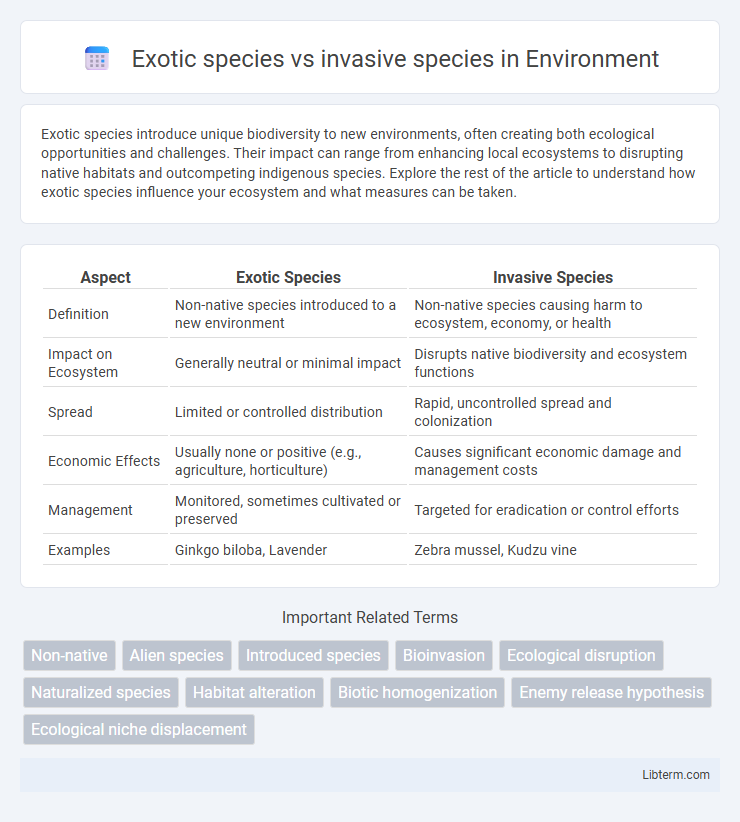Exotic species introduce unique biodiversity to new environments, often creating both ecological opportunities and challenges. Their impact can range from enhancing local ecosystems to disrupting native habitats and outcompeting indigenous species. Explore the rest of the article to understand how exotic species influence your ecosystem and what measures can be taken.
Table of Comparison
| Aspect | Exotic Species | Invasive Species |
|---|---|---|
| Definition | Non-native species introduced to a new environment | Non-native species causing harm to ecosystem, economy, or health |
| Impact on Ecosystem | Generally neutral or minimal impact | Disrupts native biodiversity and ecosystem functions |
| Spread | Limited or controlled distribution | Rapid, uncontrolled spread and colonization |
| Economic Effects | Usually none or positive (e.g., agriculture, horticulture) | Causes significant economic damage and management costs |
| Management | Monitored, sometimes cultivated or preserved | Targeted for eradication or control efforts |
| Examples | Ginkgo biloba, Lavender | Zebra mussel, Kudzu vine |
Introduction to Exotic and Invasive Species
Exotic species are organisms introduced to regions outside their native range through human activity, often for agriculture, horticulture, or pet trade, without necessarily causing harm. Invasive species are a subset of exotic species that establish, spread rapidly, and cause ecological or economic damage to native ecosystems. Understanding the distinction between these terms is crucial for managing biodiversity and protecting ecosystem health.
Defining Exotic Species
Exotic species are organisms introduced intentionally or accidentally outside their native geographic range, often through human activities such as trade and travel. These species may coexist harmlessly within new ecosystems without causing significant ecological disruption. Defining exotic species involves distinguishing them from native species based on origin, rather than their ecological impact or invasiveness.
Understanding Invasive Species
Invasive species are non-native organisms that cause significant ecological, economic, or environmental harm in new regions, unlike exotic species that may not exhibit aggressive growth or disruption. Understanding invasive species involves studying their rapid reproduction, lack of natural predators, and competitive advantage over native species, which often leads to habitat destruction and biodiversity loss. Effective management strategies require early detection, monitoring, and control measures to minimize their impact on ecosystems and prevent long-term damage.
Key Differences Between Exotic and Invasive Species
Exotic species are non-native organisms introduced to a new environment, often without causing harm, while invasive species aggressively spread, outcompeting native flora and fauna and disrupting ecosystems. Key differences include invasion potential, ecological impact, and reproductive strategies, with invasive species typically exhibiting rapid growth and high adaptability. Management efforts prioritize invasive species due to their detrimental effects on biodiversity, economy, and habitat stability.
Ecological Impacts of Exotic Species
Exotic species often introduce new competition, predation, or diseases that disrupt native ecosystems, leading to altered food webs and loss of biodiversity. Their presence can cause significant changes in habitat structure, nutrient cycling, and ecological processes, which may reduce the resilience of native species. Unlike invasive species, which rapidly spread and cause severe harm, exotic species impact ecosystems variably but still pose substantial ecological risks.
Environmental Consequences of Invasive Species
Invasive species often cause significant environmental consequences by outcompeting native flora and fauna, leading to biodiversity loss and altered ecosystem functions. Their rapid proliferation disrupts food webs, soil composition, and water availability, resulting in habitat degradation and reduced resilience to environmental changes. Unlike exotic species, which may coexist without severe impacts, invasive species typically introduce diseases, alter fire regimes, and reduce native species populations, exacerbating ecological imbalance.
Case Studies: Notable Exotic and Invasive Species
Notable exotic species such as the Burmese python in the Florida Everglades highlight how non-native animals can disrupt local ecosystems without necessarily becoming invasive. Invasive species like the zebra mussel in the Great Lakes demonstrate rapid reproduction and ecological dominance, causing significant harm to native biodiversity and infrastructure. Case studies reveal that while all invasive species are exotic, not all exotic species pose immediate ecological threats, emphasizing the importance of context-specific impact assessments.
Human Roles in Species Introduction and Spread
Human activities such as global trade, travel, and habitat modification significantly contribute to the introduction and spread of exotic and invasive species. Shipping ballast water, ornamental plant trade, and pet release are common pathways through which non-native organisms establish in new environments, sometimes disrupting local ecosystems. Effective management relies on policies targeting these human-mediated vectors to prevent ecological and economic damage caused by invasive species.
Management and Control Strategies
Management and control strategies for exotic species focus on preventing their introduction and monitoring early detection to limit establishment. Invasive species require aggressive measures such as mechanical removal, chemical treatments, and biological control agents to reduce their populations and mitigate ecological damage. Integrated pest management approaches combine these methods with habitat restoration and public education to enhance long-term ecosystem resilience.
Balancing Biodiversity: Prevention and Policy
Effective management of exotic species requires stringent prevention measures and comprehensive policies to mitigate their transition into invasive species, which threaten native biodiversity. Implementing early detection systems and regulatory frameworks can balance ecosystem health by controlling species introduction and spread. Conservation strategies must integrate habitat restoration and public awareness to sustain biodiversity while minimizing ecological disruption.
Exotic species Infographic

 libterm.com
libterm.com